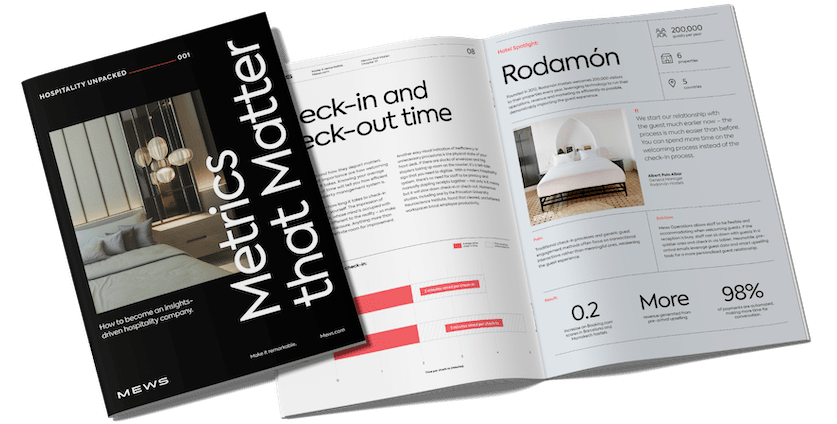Understanding the difference between yield management and revenue management is important. Although they share some similarities, they are distinct strategies and they can be used in different ways. In fact, yield management is sometimes viewed as its own branch within revenue management.
In this article, we take a closer look at both yield management and revenue management, and focus on how they differ from one another, especially when it comes to their application within the hotel industry.
Table of contents
What is revenue and yield management?
Revenue management is the practice of predicting or anticipating customer behaviour, and then optimizing pricing, product availability and distribution, in order to maximize the amount of revenue you bring in. The practice relies heavily on the collection of data and the use of analytics to identify patterns and forecast levels of demand.
Yield management is a similar concept, which also relies on forecasting and the anticipation of customer behaviour. However, it is focused solely on the sale of fixed, time-limited inventory, such as hotel rooms.
Differences between yield management and revenue management in the hotel industry
Of course, it's useful to have an overall understanding of what yield management and revenue management actually mean. But it's even more beneficial to take this to the next level and understand some of the key differences, especially in terms of how the concepts are actually applied within the hotel industry.
Yield management is centered on hotel rooms
Yield management focuses on price differentiation for fixed, time-limited inventory. To fall into this category, the thing being sold must only be available for a certain amount of time, there must be a limited amount of it, and customers must be willing to pay different prices for it. Within the hotel industry, this describes hotel rooms, which can be managed using hotel rate management software to dynamically adjust pricing and maximize revenue.
With this in mind, the basis of yield management within the hotel industry is selling the right room to the right customer at the right time, for the highest possible amount, in order to maximize revenue and/or profit from room sales. Generally, this means increasing prices during times of high demand, and decreasing prices when demand is low.
Revenue management has a wider focus
By contrast, revenue management is broader in terms of its overall focus. It too includes the use of price differentiation to maximize revenue from hotel rooms, but it also takes into consideration the revenue that is generated from other aspects of your hotel business too, such as restaurant sales, bar sales, room service, and spa bookings.
Beyond this, revenue management strategies are much more likely to take into consideration other factors, such as the costs associated with certain distribution channels. As a result, it tends to be more heavily reliant on the gathering and analysis of data, and it may also require input from different departments within the property.
Yield management is highly tactical
To get the most from yield management, hotels need to embrace a tactical approach to pricing and other aspects associated with selling hotel rooms. A good example of this is identifying the best restrictions to apply to the sale of those rooms, in order to maximize the amount of money generated by them over time.
For example, one restriction that may be applied to a hotel room booking is the maximum length of stay. In some situations, it may be more beneficial to apply a strict limit to the duration of the stay, while in others, such as periods of low demand, it may be better to offer greater flexibility, in order to encourage longer stays.
Revenue management is more broadly strategic
When it comes to hotel revenue management, the best results will be achieved by being more broadly strategic, giving consideration to different elements of the business and using a wider range of key performance indicators, including metrics like RevPAG (revenue per available guest), RevPAR (revenue per available room) and GOPPAR (gross operating profit per available room).
To manage revenue effectively, you'll need to consider the distribution channels you use and whether different channels should offer rooms at different room rates. However, as the focus is not solely on hotel room sales, there may be situations where other aspects of the hotel are prioritized in any pricing strategies too.
Conclusion
A significant part of hotel management involves optimizing financial results, and both yield management and revenue management have a role to play. The former is focused on optimizing pricing for hotel rooms, so that your hotel generates maximum revenue from room sales. By contrast, revenue management has a broader focus, factoring in other aspects, such as revenue generated from restaurant and spa sales, and the costs involved in generating bookings.
Yield management is sometimes considered an individual branch within revenue management and it can be especially useful for tactically managing the core product associated with hotels: the rooms. However, the broader focus of revenue management can also be valuable, providing more of a 'big picture' view of business performance.
Track the right metrics

How does your property measure performance? With an almost endless amount of data available, tracking the right metrics is key for success - and we're here to guide you.
Your first port of call is our Metrics that Matter report. It features case studies and key stats on how hotels are benefitting from data across different departments in their hotels, ultimately helping you to shape operational, financial and marketing decisions.

2026 Hospitality Industry Outlook
Download now
Table of contents
Hospitality hot takes straight to your inbox



.webp)
